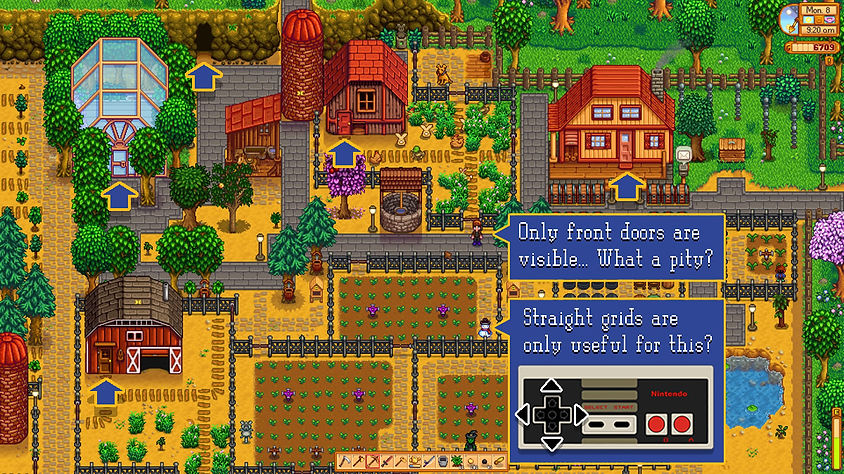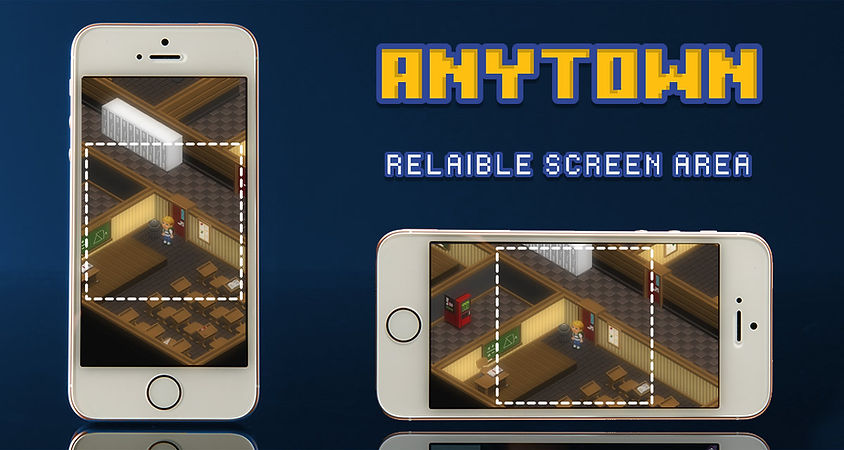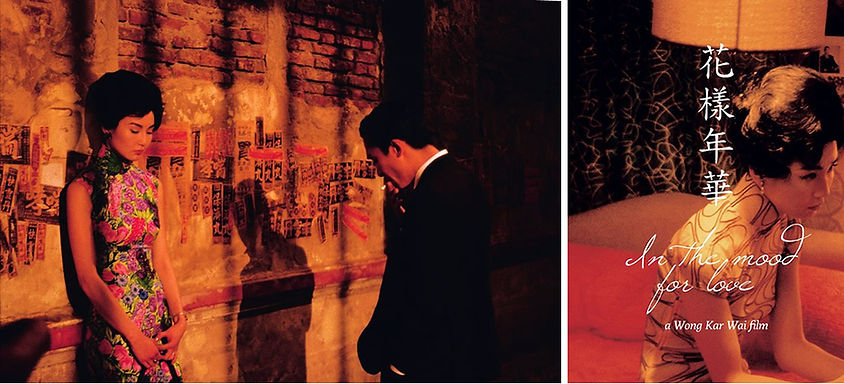While designing a game, it is very easy to get lost in the set of features that might fit into the project and over the time game would turn into a feature creep project with lots of mechanics or dynamics that doesn't create any harmony together. So all game design ideas need to pass through a filter which only allow the ideas that follow the direction the game focused on. This filter is a set of rules which called as "Design Pillars". Imagine the game experience as a building. These pillars are the very foundation of the building. Every single detail of the building must depend upon at least one of these pillars and any detail of the building must never contradict to any of these pillars. On this metaphor, the players are the residents of the building. In a building with thousands or millions of residents, without any suspicion none of a detail remains untouched. And for this reason, any unnecessary or conflicting detail would damage the pillars which keep the building together. On the game side, it would ruin the game experience, disturb the flow, break the immersion.
The design pillars below are the foundations of Anytown - Garage Sale Monsters:
[Pillar 1] - Mobile Oriented
Even it will be available on PC and other platforms, unlike other story and exploration based RPG games, Anytown is a game which mostly focuses on Android and IOS platforms. Genre is 100% popular in PC and consoles and a solid fanbase is expected through Steam and other console platforms. None of these games exist on mobile platforms, because simply they didn’t thought as a mobile experience on the first place. We are very willing to take this opportunity/risk by thinking it as a mobile experience from the start.
[Pillar 2] - More by Less (Not Less is More)
Correlated to mobile device memory, storage and bandwidth capability limitations, game must offer more content with less graphics and sfx. Also another limitation is the screen sizes, which is commonly variant in mobile phones and tablets, so game must offer huge content in less space. To achieve these goals, game must very strictly choose its design, technical and artistic decisions.
[Pillar 3] - Interruption Is Forbidden
Mobile is a medium that an interruption from the external environment is inevitable. For this reason, game have zero tolerance to immersion breaking design choices. Flow must be never disturbed internally. Even if it is disturbed by external factors, game must offer a smooth adaptation chance back, anytime, anywhere.
[Pillar 4] - New Retro: Try To Embrace Before Innovate
Game must acknowledge the legacy games of the genre in both art style and game mechanics. All artistic and design choices must have a critical responsibility to keep the retro look and feel of the game. When the good-old game mechanics meet with brand new requirements, some design problems are always inevitable. As the first option, design choices must always try to embrace the disadvantages of the traditional genre by turning them into unexpected advantages. Only if these mechanics are conflicting with a better mobile experience and if there is no creative workaround, then these mechanics must be replaced by new and innovative alternatives. Mobile standards are not defined for this genre, so it is also a perfect opportunity to be the game that defines them.
[Pillar 5] - Choices Does Matter
It is important to understand that Anytown is a game about player choices. Every simple choice must have complex relations and results to experiment with.
Anytown is an RPG game that built upon daily tasks of a school kid such as have a breakfast, go to school, take lessons, return home, play with dog, eat dinner, go to sleep. Even missing all of these daily tasks doesn’t have any ‘Game Over’ condition. In Anytown, there are no wrong choices: the game never punish the player for their life choices, rather it rewards the player with different and interesting narratives for choosing their unique way. Anytown offers a unique, non-repeating adventure on each day of a full game year.
[Pillar 6] - Non Participating Is Still A Choice
Other than these daily tasks, Anytown massively include two abstract game play values: as an Nonlinear Adventure which allows to be played just as a story rich narrative game, or as a Collectible Card Game which involves tactical monster raising game.
When it comes to player choices, even it involves incomplete or non participation of the player, game must be flexible about it. These types of choices must be categorized as abstract modes with strict design rules. It is also important to carefully guide the player, how to recognize and avoid an undesired mode.
[Pillar 7] - We Are A Couple, Not An Army
Anytown is developing by a couple with almost-zero-budget limitation. Accepting free vision/advice from anyone is very critical. Resource management is very critical when taking such a risk. Every design decision must be limited to these resource restrictions.
Product Overview
The list below is the all artistic, technical, business and design choices decided through the process. Correlated design pillars are referenced for all decisions made.
- Game must be playable on all casual mobile platforms that everybody own [Pillar 1].
- No payment required to start playing [Pillar 1].
- Absolute and one time payment is required to progress in the game (blocked by a single content gate) [Pillar 1].
- Playable even in difficult to play environments and conditions (Bus, Office, Toilet, Bed) [Pillar 1, 2,3].
- Playable even while offline (Metro) [Pillar 1, 2, 3].
- Game must be easy to learn. It must be VERY easy to learn [Pillar 1]. Iterate the intro (first) level until it evolves into a simple but elegant one [Pillar 2].
- Game must allow both vertical and horizontal orientation. Vertical orientation must be assumed as the main option for mobile phones to allow single handed game play with a single finger [Pillar 1].
- Pacing adjustable by the player. Game stops when the player stops [Pillar 1, 3]. No need for a pause button [Pillar 1, 3]. No reflex is required to play the game [Pillar 1, 3].
- Adaptable session lengths adjustable by the player. Can be played even for 2-3 minutes [Pillar 1].
- Game auto save-loads. Multiple save points is not a suitable option for mobile [Pillar 1]. Anywhere, even in a battle, if the game shuts down, it must restart in exact position [Pillar 3].
- There is no permanent loose condition (Game Over) [Pillar 3].
- If a critical (major) card battle is lost, there is always another chance to make it again that still keep player inside the quest [Pillar 3]. For a better pacing, making these battles available only on specific periods in the game calendar (ex: specific time of every day/week/month)
- Sometimes punishments are allowed by returning player to a start point of a sequence of multiple battles (not in a “loaded back to a save point” fashion, but in a more diegetic way followed by the narrative) or by not giving a reward that dropped from random encounters [Pillar 3].
- There must be no good/bad narrative choices. All of the choices must award the player by an interesting variation in the story [Pillar 5,6].
- There must be no single-way-earned awards. Narrative player decisions and multi-choice card battles must be awarded with variant-but-equivalent gifts that could be trade-able with lower conversion rates [Pillar 5,6].
- Anytown offers two separate fun all-in-one: Narrative and Card Battle. In both modes, the game must offer content-rich choices to the player [Pillar 5], but these two modes must be separated completely from each other and player must have a chance to play the game involving in both modes or only one of them [Pillar 6]. These two modes must be considered just as two different games that could be played in same game world [Pillar 6].
- Considering the total separation of Card Battle and Narrative modes, surprise attacks/encounters designed for the Card Battle mode must be designed precisely [Pillar 6]. These types of surprise events must be triggered only in the areas and zones that was gated by another Card Battle/Quest NPC that player could choose to participate by free will [Pillar 5, 6].
- Considering the total separation of Narrative and Card Battle modes, surprise events designed for the Narrative mode must be designed precisely [Pillar 6]. These types of surprise events must be generated only linked to a previous Narrative/Quest NPC that player could choose to participate by free will [Pillar 5, 6].
- Every time player open the game, there must be a smart and skippable intro-scene like in TV series. It is a cutscene of important events happened before [Pillar 3]. This, “on the previous chapter of Anytown” intro help player to adapt back to the game between long mobile session delays [Pillar 1] and increase memorization of important characters in a shorter period [Pillar 2]. Side Note: This is an extra feature that could prolong development plan. It must be discussed to be considered after play tests.
- RPG genre was always very popular in handheld consoles since good old Gameboy days to new Nintendo 3DS & PS Vita generations. Even though, all of these devices offers a built in 4-way input controller and action buttons (that also found a perfect ground in PC through keyboard keys). This input methodology is a sharp restriction for PC/Console/Handheld games of the genre. It makes harder to port them naturally to casual mobile phones. Anytown offers a new and deeply thought input model through native single finger tap / swipe gestures [Pillar 1, 4].
- Zelda-like grid-based worlds are the early foundations of RPG genre, but it only offer interesting solutions for old handheld and console devices such as Gameboy and NES. Casual mobile devices allow diagonal interaction by touch and Zelda-like perspective is a burden for retro-looking games [Pillar 4]. For that reason crosswise isometric perspective chosen as a design choice to double the visibility [Pillar 2].

- Reliable visible screen area is square due to mobile limitations [Pillar 1]. Sequences and cutscenes must avoid further spaces for important events [Pillar 2].

- Due to crosswise isometric perspective and a blocking hand of the player, south area of the camera has lesser visibility [Pillar 1]. This blindness increases, if the player prefers the horizontal orientation [Pillar 1]. Never use this space to introduce new characters and elements.
- Considering a crosswise isometric perspective, using north for progress direction is vital. Also, traveling north instead of south would significantly reduce map sizes and allows more visible content in less space [Pillar 2]. Even so, traditional isometric north-east progress direction critically fails and needed to be replaced [Pillar 4]. Instead, north-west picked for progress direction, considering best-practices for mobile [Pillar 1]




- Also as a reverse progress direction, south could be useful for hiding secret places and adding a mystery tone to some level designs [Pillar 4]. Dark toned levels such as ”Dark Alley” might be good examples to work with this idea. Progressing reverse to the south could help hiding some thugs and mystic strangers faces from the player [Pillar 4]. Long objects and walls could be also useful for hiding surprise events behind [Pillar 4]. It is important to hide these surprises from the screen direction, not from the avatars sight [Pillar 1].
- Text should be as short as possible [Pillar 2].
- NPC names are always 3 letter length.
- Monster and Spell names must be smaller than 12 letters.
- Monster abilities and spells are always 4 letter words.
- Dialog frames are limited by 75 glyphs.
- Anytown is open to any sexual orientation on romantic narrative lines. It is achieving this narrative challenge by simply never mentioning about the gender of "You" and let the players handle this answer in their imagination as they wish [Pillar 2]. Player could wear/change any gender-specific clothes and narrative doesn’t branch to gender specific paths [Pillar 5, 6]. This design decision could be expanded in the future to more complex narratives, yet it require good research and resource limitations block any gender narrative expansion for now.
- Even crosswise isometric perspective is widely used in games history, it is never thought as a dramatic composition tool [Pillar 4]. For instance, dual characters with reverse poses, which positioned in a crosswise isometric space or a lonely cross sitting character gazing in empty space might create an intense dramatic composition. Research is needed for similar composition techniques in movies [Pillar 4].



